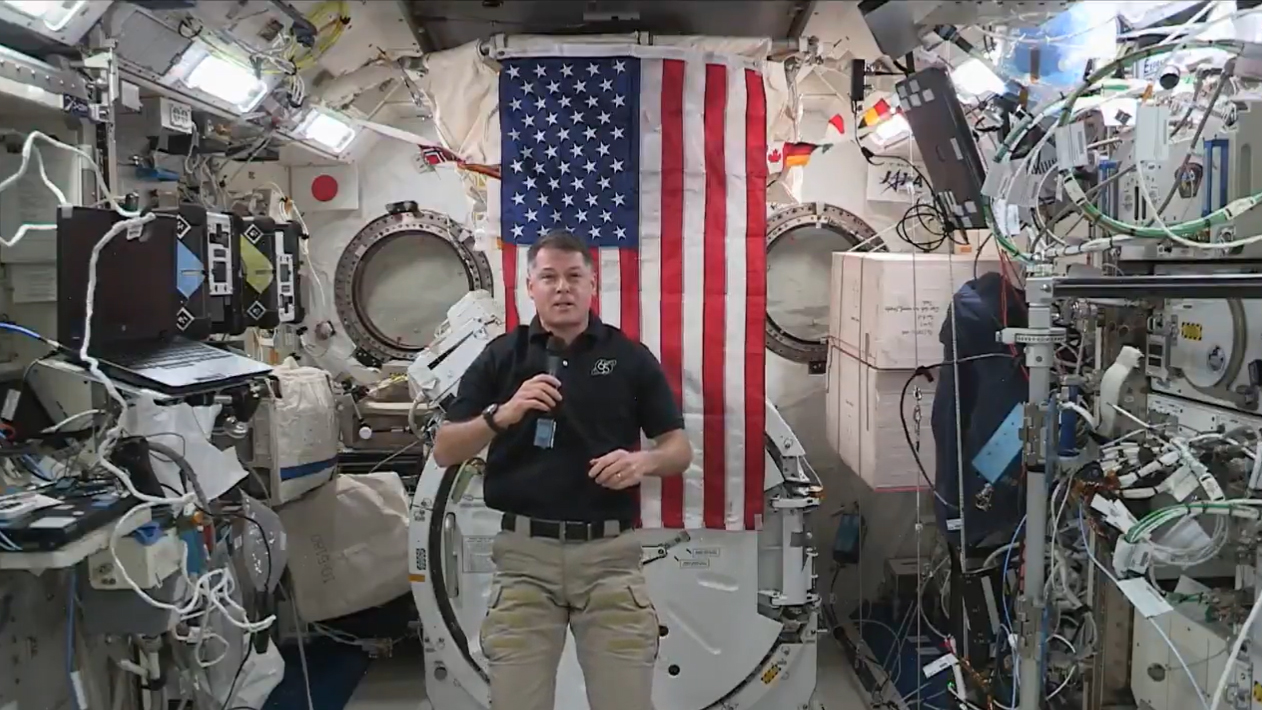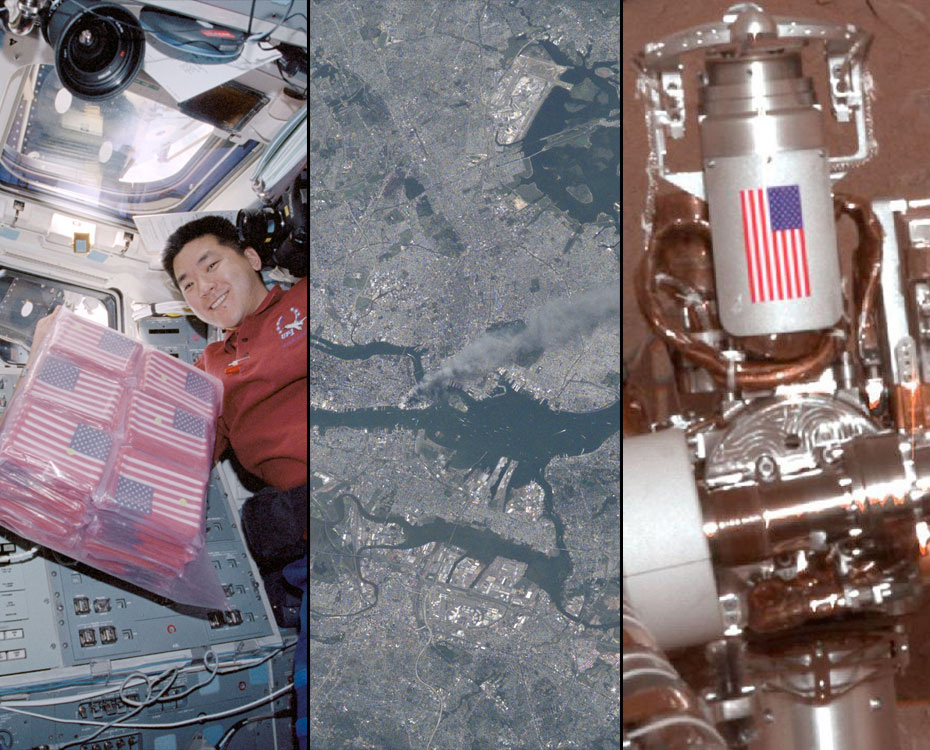Astronauts in space pay tribute to 9/11 victims on 20th anniversary of attacks
"We will never forget," says NASA astronaut Shane Kimbrough.
As solemn ceremonies across the United States mark the devastating terrorist attacks 20 years ago today on Sept. 11, 2001, astronauts in space are also paying tribute from the International Space Station.
NASA astronaut Shane Kimbrough, one of seven crewmembers on the station representing the U.S., Russia, Japan and France, beamed a memorial video message to Earth to honor those lost and affected by the 9/11 attacks on the World Trade Center in New York City, Pentagon in Washington, D.C. and the Flight 93 crash in Pennsylvania.
"To the victims and their families, survivors and first responders, we remember," Kimbrough said with an American flag floating in the background as he spoke from the station's Japanese Kibo laboratory. "The horrifying images of that day are still present in so many of our minds."
Related: 9/11 remembered in space photos
More: 20 years after 9/11: How satellites tracking disasters have changed

Kimbrough said that while many others struggled to comprehend the impact of the attacks, the events also spawned a wave of patriotism among Americans in support of the attacks' victims and first responders. He thanked those in the military service and elsewhere who worked to prevent such attacks in the future.
"As we remember 9/11 20 years later, despite that time of tragic loss and grief, it was also a time we saw the strength and resilience of our a nation, and the incredible support from people all around the world," Kimbrough said. "For those of us who lived through that painful time, we've had the opportunity to share what we have learned and what we can accomplish together as a country, and for all of humanity."
.@NASA astronaut @Astro_Kimbrough marks the 20th anniversary of the September 11 terrorist attacks with remarks from the International Space Station. “We will never forget,” says Kimbrough. pic.twitter.com/O2d8LAM46WSeptember 11, 2021
NASA and its partners have repeatedly honored the memory of those lost in the 9/11 attacks with ceremonies on Earth, in space and memorials on other planets.
Get the Space.com Newsletter
Breaking space news, the latest updates on rocket launches, skywatching events and more!
As the attacks unfurled in 2001, American astronaut Frank Culbertson watched with horror from aboard the International Space Station as he recorded videos and photographs of vast plumes of smoke from the World Trade Center site in New York City. The camera he used for those photographs is now in a museum display in Kansas.
Related: Astronaut Frank Culbertson Reflects on Seeing 9/11 Attacks from Space
"The world changed today. What I say or do is very minor compared to the significance of what happened to our country today when it was attacked," Culbertson wrote in a letter a day after the attacks. "It's horrible to see smoke pouring from wounds in your own country from such a fantastic vantage point. The dichotomy of being on a spacecraft dedicated to improving life on the Earth and watching life being destroyed by such willful, terrible acts is jolting to the psyche, no matter who you are."
Culbertson used a trumpet aboard the station to play Taps for his Naval Academy classmate Charles F. "Chic" Burlingame, who had been the pilot of the hijacked airliner that crashed into the Pentagon.
In December 2001, NASA flew 6,000 small American flags on the space shuttle Endeavour's STS-108 mission as part of its Flags for Heroes and Families campaign victims of the attacks in New York, Washington, D.C. and Pennsylvania. The flags were later distributed to victims on Flag Day (June 14) in 2002.
Honeybee Robotics, which built instruments on NASA's Mars rovers Spirit and Opportunity, used aluminum recovered from the World Trade Center site as cable shield cuffs on the rovers. "The metal bears the image of an American flag and fills a renewed purpose as part of solar system exploration," NASA wrote in a statement.
NASA's Kennedy Space Center also contributed American flags that were sewn into a larger, tattered flag now known as the National 9/11 Flag that was recovered near the World Trade Center site after the attacks.

Kimbrough said the International Space Station, the largest human-built object in space and the product of five different space agencies and over 15 countries, is an example of what humanity can do when it works together.
"Here on the International Space Station over the last 20 years, we've been continuously living together in space, while operating among many nations to improve lives for all of us back on Earth," Kimbrough said. "People from all over the world and from all walks of life joined together to accomplish the incredible engineering feat of building an international space station in low Earth orbit.
"The space station is now entering its third decade in the era of full scientific utilization expanded commercial value and global partnership. We will never forget."
Email Tariq Malik at tmalik@space.com or follow him @tariqjmalik. Follow us @Spacedotcom, Facebook and Instagram.
Join our Space Forums to keep talking space on the latest missions, night sky and more! And if you have a news tip, correction or comment, let us know at: community@space.com.

Tariq is the Editor-in-Chief of Space.com and joined the team in 2001, first as an intern and staff writer, and later as an editor. He covers human spaceflight, exploration and space science, as well as skywatching and entertainment. He became Space.com's Managing Editor in 2009 and Editor-in-Chief in 2019. Before joining Space.com, Tariq was a staff reporter for The Los Angeles Times covering education and city beats in La Habra, Fullerton and Huntington Beach. In October 2022, Tariq received the Harry Kolcum Award for excellence in space reporting from the National Space Club Florida Committee. He is also an Eagle Scout (yes, he has the Space Exploration merit badge) and went to Space Camp four times as a kid and a fifth time as an adult. He has journalism degrees from the University of Southern California and New York University. You can find Tariq at Space.com and as the co-host to the This Week In Space podcast with space historian Rod Pyle on the TWiT network. To see his latest project, you can follow Tariq on Twitter @tariqjmalik.









